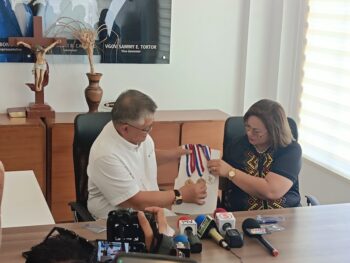MALAYBALAY CITY (MindaNews/23 June) — The rationing of water supply in several barangays in the city is due to uneven pressure in the city water system’s pipelines, not due to lack of water supply, Carlos Mendoza, a geohydrologist and geophysicis, said.
In the presentation of study results last Tuesday, Mendoza allayed fears of water shortage, noting that water supply from the Kibalabag source is sufficient until 2021. He recommended, among others, to install booster pumps to increase pressure in three points of the distribution system to correct “uneven distribution” and to address “voluminous systems loss.”
Mendoza’s team was commissioned y by the city government as independent experts, to check on the MCWD distribution system. They presented a computer simulation program to show how to cope with uneven pressure.
Mayor Ignacio W. Zubiri said the Malaybalay City Water District (MCWD) had earlier recommended additional pipes and tanks costing P30 million.
He said the MCWD recommendation is “too costly” while booster pumps cost from P2 to P3 million only.
The water district buys most of its water for its close to 13,000 consumers from the Malaybalay City Government Water Supply System (MCGWSS), an economic enterprise created by the city tapping water from the Kibalabag source.
Mendoza, commissioned by the city government to conduct a review of the city’s water distribution system, released the results of their three-month study on June 19, more than a year after MCWD sent a proposal to Zubiri on February 23, 2011 seeking support to finance a P30-million project to “address water shortage in some parts of the city.”
The MCWD uses gravity, not pumps, to distribute water and admitted that in the BLISS Area southeast of downtown Malaybalay, location of close to 20 percent of their consumers, there are hours when supply could not cope with the demand.
“We have to stop releasing from the tank proximate to the area to gather enough before we release again hours later,” Engr. Resi Alonzo of MCWD’s engineering department said.
MCWD has initiated a P13 million parallel piping project to transmit water from the Sumpong reservoir straight to the tank in NHA-3 to improve service in the BLISS area.
But the same problem is observed in some portions of the rest of the city proper, Alonzo added. Among the downtown areas with problematic water distribution are barangays 4,7,9, 10, 11 and Casisang, the subject of the P30-M proposed project.
He said they want to install a parallel water transmission line from the city’s treatment plant in Sitio Kimambong to Barangay 1 to augment water supply. The 8-inch PVC pipeline is envisioned to connect the plant to two new 500-cubic meter water tanks, bigger than their present tanks.
Mendoza’s team was commissioned to check on the MCWD distribution system as “independent experts.” They ran the computer simulation program to show how to cope with uneven pressure.
Dr. Violeta Tabios, MCWD director, invited the consultants to their next board meeting to discuss the findings further.
Zubiri appealed to MCWD to forego with its P30 million project. The city government instead offered to foot the bill to install the pumps recommended by the consultants.
“We can’t help you with the P30 million. We have a more pressing problem,” he said.
Zubiri said they have to allot about P10 million to install a diversion pipe to alter a portion of their pipeline from source to reservoir “right away.” (Walter I.
Balane/MindaNews)
